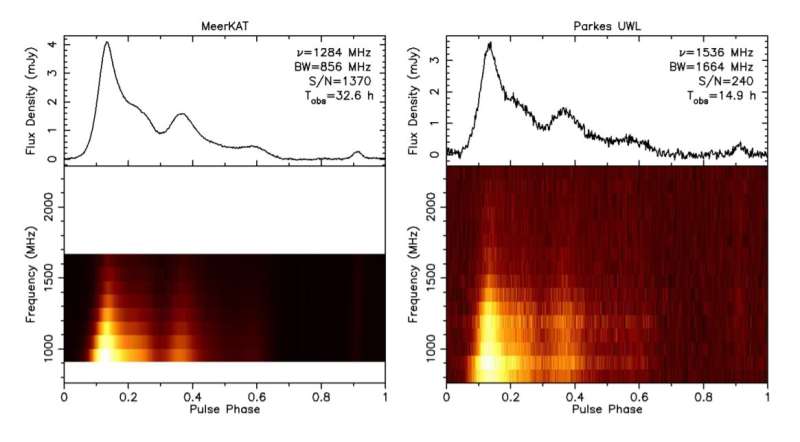March 9, 2022 report
Study sheds more light on the nature of millisecond pulsar PSR J0955−6150

An international team of astronomers has performed timing observations of an eccentric millisecond pulsar known as PSR J0955−6150. Results of the observational campaign, published March 1 on the arXiv pre-print server, deliver important insights into the nature of this object.
The most rapidly rotating pulsars, those with rotation periods below 30 milliseconds, are known as millisecond pulsars (MSPs). It is assumed that they are formed in binary systems when the initially more massive component turns into a neutron star that is then spun-up due to accretion of matter from the secondary star.
Discovered in 2015 by the Parkes radio telescope, PSR J0955−6150 is an MSP with a spin period of 1.99 ms. Like most MSPs, this pulsar is part of a binary system with a presumably helium white dwarf (He WD) star. The binary has an orbital period of approximately 24.58 days and a relatively high orbital eccentricity—at a level of 0.12. Therefore, PSR J0955−6150 was classified as an eccentric MSP (eMSP) and turns out to be one of the most eccentric out of the known eMSPs with He WDs.
A group of astronomers led by Maciej Serylak of University of the Western Cape in Cape Town, South Africa, decided to investigate PSR J0955−6150 with Parkes and MeerKAT radio telescopes, hoping to get more insights into the nature of this pulsar, which could also improve our understanding of the population of eMSPs hosting helium white dwarfs.
"PSR J0955−6150 is a member of an enigmatic class of eccentric MSP+He WD systems (eMSPs), whose binary evolution is poorly understood and believed to be strikingly different to that of traditional MSP+He WD systems in circular orbits," the researchers explained.
The study revealed a strong frequency evolution of this pulsar's intensity, with a flux density spectral index of −3.13. It turns out that PSR J0955−6150 is located some 13,000 light years away from the Earth and its proper motion is relatively small—only 0.2 mas/year.
It was found that the pulsar has a mass of approximately 1.71 solar masses, while the mass of the companion star is about 0.25 solar masses. The orbital inclination of the system was measured to be 83.2 degrees.
The astronomers noted that, while the mass of the pulsar is typical for eMSPs, the mass of the companion He WD is significantly smaller than expected. They emphasized that none of the currently known hypotheses are able to well explain the low mass of the companion to PSR J0955−6150 and its orbital misalignment.
"This means that the formation of eMSPs remains a major puzzle of close binary stellar evolution," the researchers wrote.
They see the low mass of the companion to PSR J0955−6150 as an important, but hard to interpret, clue on the poorly understood formation of eMSPs.
More information: The eccentric millisecond pulsar, PSR J0955−6150 I: Pulse profile analysis, mass measurements and constraints on binary evolution, arXiv:2203.00607 [astro-ph.HE] arxiv.org/abs/2203.00607
© 2022 Science X Network



















